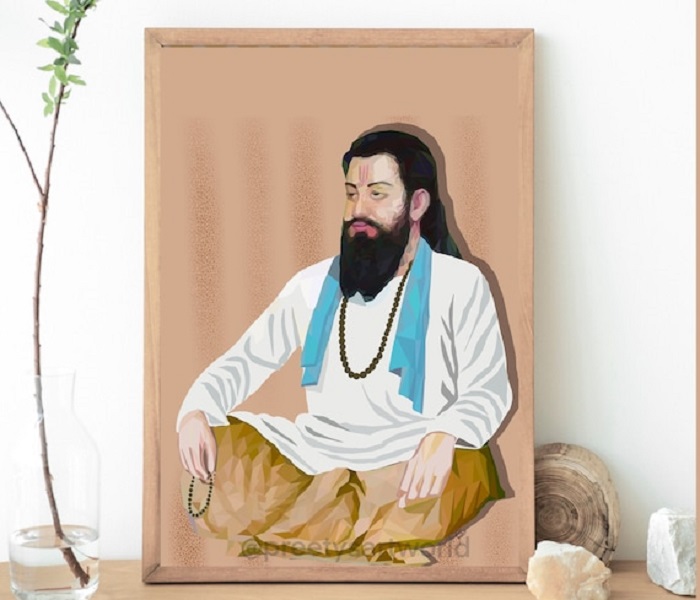(Kanwal Bharti)
(English translation from original Hindi: SR Darapuri, National President, All India Peoples Front)

(Asian independent) The first intellectual work on Sant Raidas was done by Chandrika Prasad Jigyasu in 1960. The name of his book was ‘Sant Pravar Raidas’, which was in two volumes, and in this he discovered the Raidas of history. According to Jigyasu ji, the naming of Raidas as Ravidas started from Guru Granth Sahib. He has written that a lot is written about the word ‘Ravidas’ in prose and poetry. A Ravidas sect started, and the Ravidas-panthi saints propagated Surya-worship (Sun Worship) a lot. Describing this Surya-worship, he has written: ‘Maharshi Ramdas ji, resident of Narayanpur in Farrukhabad district, is already propagating it, while Adbardas ji of Sahijanpur, district Lucknow has also published many books. One of these books is named ‘Hare Ravi Bhajan Mala Sumiran’. It has 68 Sakhis and Ravinam Kirtan. The chant is this—Hare Ravi, Hare Ravi, Ravi-Ravi Hare-Hare. Hare Surya, Hare Surya, Surya-Surya Hare-Hare. (Page 90-91)
It means that a new parallel stream named Ravidas started, which started from Punjab, but spread everywhere. Although the force of this stream is still more in Punjab.
The basic difference between history and literature is that literature runs on imagination, and history describes time, environment and circumstances. If history is run on imagination, then nothing will happen to history, but literature will be ruined. The work of distorting history and decorating it with imagination is not new, many Hindu historians, especially historians associated with RSS, have done this work a lot. They have disposed of almost all the heroes of resistance by making them Brahmin-devotees. This is not history-writing, but cheating with history. Neither Buddha, nor Kabir-Raidas nor Ambedkar could escape from this deceit. I had shown some glimpses of this deception on Facebook through Dr. Manoj Dahiya’s article. On that some people asked, ‘Then what is the truth? You tell me?’ Such questions cause pain. If it is denied that Raidas Saheb had sung bhajans while sitting in a temple or had shown the sacred thread by slitting his stomach, then they will ask, then what is the truth? Such questions are asked by those who lack both intelligence and ideology. Those who have the ideology of Raidas Saheb cannot ask such questions. Therefore, first of all, there is a need to understand the ideology of Raidas Saheb. When they understand his ideology, they will also know the truth. If historical awareness and ideology are in front, then the truth comes out through logical analysis, and if this is not there, then keep making illogical arguments, nothing will be gained from it.
According to Manoj Dahiya, Raidas ji had a leather business, or a shoe factory, and he was from a rich family. Is this true? The correct basis for knowing this can be what Raidas himself has said about himself. Nothing special is found in Raidas ji’s Vaani about this. Kabir Sahab has written a lot about his caste, his profession and his family. He has described the entire process of weaving cloth, has told how the weaver’s goods are bought at a very low price in the market, has mentioned the loom and tools. But there is no description related to his profession in Raidas Sahab’s Vaani. Raidas ji has not mentioned in his poems what all methods are used in making shoes. We find two poems about his work and caste. These poems are also found in the collection of Ravidasiya sect. It is said in one of the poems – Chamarta gant na jaani, log gathaave paanhi.
And nahi jahi toupu nahi ravi thaau thau plante.
People have made genuine shoes and I have to go to the fair without them.
Ravidas chants the name of Ram; I have no desire to see him.
Sant Surinder Das Babaji has given a supernatural interpretation of this verse in this way: ‘I do not know how to have false love for the body made of leather. Worldly people come to me to get false knots with material things to stitch their body.’ (Amrit Vani Satguru Ravidas Maharajji, page 54)
Why did Surinder Das not give the worldly meaning of this verse? Why did he give this wrong supernatural meaning? Only he knows this, but the worldly meaning of this verse is that Raidas Sahib is clearly saying in this that he does not know the work of making shoes or repairing shoes. He says that he neither has a dart nor a hook. This shows that Raidas Sahib did not have the profession of making shoes or repairing shoes. Hindu people used to bring shoes for repair with the intention of insulting him on the basis of caste. In those times, such insults are not impossible. It is not necessary that a cobbler will make shoes. It is a stereotype that if Raidas was a cobbler, he must have been doing the work of making or stitching shoes. There is a need to get rid of this stereotype.
There was a Mahatma Ram Charan Kuril from Kanpur, who wrote ‘Bhagwan Ravidas Ki Satya Katha’ (1947) and made him an incarnate God. He has written such stories which have no meaning. He also did not give the name of Raidas Sahib’s father. Jigyasu has given his father’s name as Raghuram. But Punjabi Ravidasiyas say his father’s name was Santokh Das. Neither Raghuram nor Santokh Das have any historical basis. Raidas has also not mentioned his parents in his speech. Therefore, there is no use in making up imaginations.
People of Ravidasiya sect say that Raidas Sahab’s financial condition was very good because his father had a factory. But this thing is proved wrong by the words of Raidas ji. This verse of his is found in the collection of Ravidasiya sect, in which Raidas ji says that we were so poor that people used to laugh at our condition. For example: ‘Everyone laughs seeing poverty, such is our condition.’ In another verse, he talks about his dirty and torn clothes, the more he stitches them, the more they tear. For example:
What is the dirty cloth, if I wash it once, I will not be able to sleep.
The more I stitch it, the more it gets torn, the more I burn it, the business of a fake person is ruined.
In another verse, Raidas ji also mentions his caste. This verse is also found in the collection of Ravidasiya sect. In this Raidasji says that his caste is famous by the name of Chamaar, whose family members live around Banaras and do the work of carrying dead animals. For example:
Nagar Jana Meri Jaati Bikhyat Chamaar.
Meri Jaati Kutbandla Dhor Dhovanta
Nithi Banarasi Aasa Paasa.
Along with Kabir Sahib, many stories have been fabricated about Raidas Sahib, which are baseless and have no relation with history. For example, Raidas ji was a Brahmin celibate in his previous birth, and once he had brought alms from a trader who had dealings with Chamars. When Thakur ji was offered food made from that material, Thakur ji refused to accept the food. Then Ramanand found out what the matter was, and he came to know that Thakur ji had been offered food made from the material brought from a trader who had dealings with Chamars. He became very angry and cursed Raidas ji to be born in a Chamar’s family in his next birth. As a result of the curse, Raidas ji was reborn in a Chamar’s family. But he believed that he was a Brahmin, so as soon as he was born, he refused to drink the milk of a Chamari mother. His mother became worried. Ramanand was famous in the village. His mother went to Ramanand crying and said, “Look Maharaj, what happened to him, he is not drinking milk?” Then Ramanand realized that he is his own disciple. Then he whispered a mantra in the ear of the child Raidas and ordered him to drink his mother’s milk, and Raidas ji started drinking milk. Can this baseless story be believed? Is it possible that a one-day-old child refuses to drink milk? Chandrika Prasad Jigyasu has written that this story is unnatural, unscientific and false, which has been fabricated only to establish the terror of the Brahmin curse. A story was also fabricated that Raidas ji had ripped open his stomach to show the sacred thread to prove himself as a Brahmin. There is no dearth of fools who believe this even now. Someone should ask them whether the sacred thread is worn on the body or inside the body? And who would have worn it inside the body and how? Can it be believed that Raidas ji would have committed the folly of ripping open his stomach to show the sacred thread? This story is a spiritual cover-up of the incident of Raidas ji being murdered with a sword. This murder of Raidas ji was probably done by the feudal lords in Chittor with the conspiracy of the Brahmins when he had gone to Chittor on the invitation of Meerabai. Here also the story was fabricated that in Chittor, Raidas ji had performed a satsang by singing bhajans and kirtans in the temple of Krishna. Why would a Nirgunvadi saint worship a Sagun? Why would he go to the temple, when the entire Nirgun movement was anti-temple? Nirgun does not only mean that God has no form or colour, neither does he take incarnation, nor does he give birth or kill anyone, but also that there is no other world, nor salvation. Then the story of Ganga in a pot is also false. Firstly, because Raidas ji did not make shoes, so why would he keep a pot? And, secondly because Nirgunvaad does not believe in divinity in any river or mountain, let alone Ganga. In their view, Ganga was only a river, nothing else. Of course, rivers have worldly importance, but no other worldly importance. Thirdly, it is also worth mentioning that the verse “Man changa to kathoti mein Ganga” was said by Raidas ji, it is not found anywhere in his speech. It is not even in Ravidasiya Raidas-Vani. Not only this, this verse has not appeared anywhere in all the verses and words of Raidas ji found till now. This verse is actually of Guru Gorakhnath, which is as follows –
Avdhu man changa to kathoti hi Ganga. Bandhiya Melha is the disciple of the world.
Bandant Gorakh is the true form,
Tat Bichare Te Resh Na Roop.
(Gorakhbani, Sabdi, 153, page 53)
I don’t know how this verse of Gorakhnath became popular in the name of Raidas Saheb? Undoubtedly this is the handiwork of the same Brahmins who moulded Raidas as a cobbler. Actually, Raidas Saheb needs to be established historically, not the Raidas Saheb of legends and stories.








